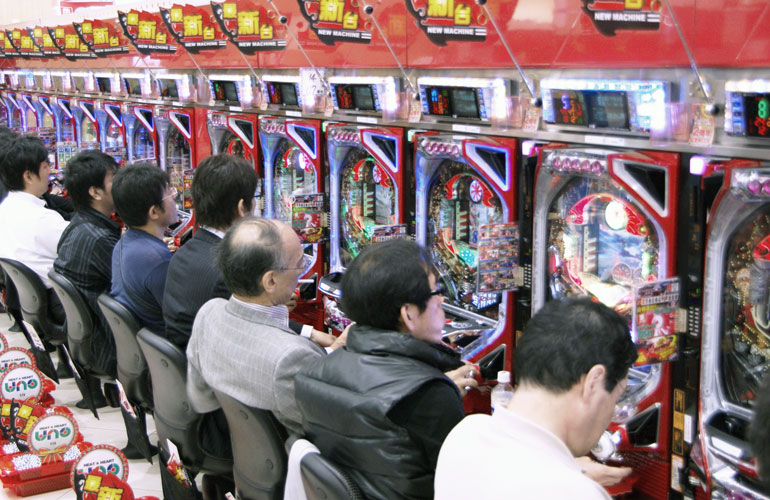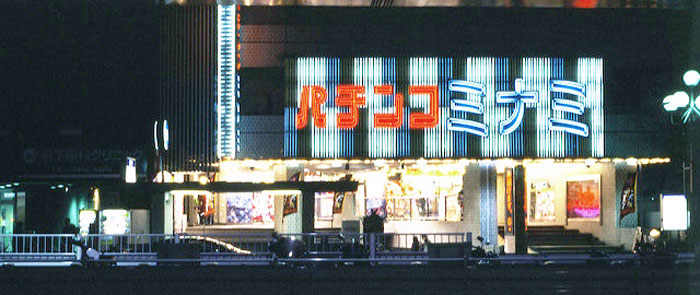
Pachinko is a traditional Japanese form of gambling, and only in this country are you able to enjoy the genuine atmosphere of Pachinko parlors. If you plan on visiting Tokyo, or any other city in Japan, it would be good to know all the Pachinko rules first.
Pachinko — What Is It?
The first electro-mechanical Pachinko machine came out during the 1970s, and it took Japan by storm. Although Pachinko greatly resembles a slot machine, it is actually a combination of the pinball game and a slot. Considering how the Japanese and gambling never quite functioned together, Pachinko is the most logical solution. In the eyes of Japan’s constitution, it is not a gambling machine because it doesn’t reward money. Considering how it grants special prizes such as jewelry, candy, or clothing pieces, it perfectly operates in the gray zone of the law.
Today, you can find thousands of Pachinko parlors all over Japan, and they’re filled with players at all times. All the flashing lights and the tense atmosphere in many parlors greatly resemble those in Las Vegas, although many claim Tokyo does it even better.
You may think of Pachinko as an upgraded slot — it takes gambling to a whole new level, and it occupies your attention for longer.
How Does It Work?
First, you need to find a proper Pachinko parlor — although there are legal bodies that regulate most of them, some pay out less than others. You will know this by simply checking if the place is crowded or not. The Japanese love playing Pachinko, and most parlors even have lines of people waiting to enter. So if a certain parlor is empty most of the time, then you should probably avoid it and find a better one.
Once you sit at a Pachinko machine, you will notice two numbers at the top. The bigger number (in size) signifies how many spins there were prior to you. The smaller number signifies wins out of all the spins on a Pachinko machine. Seasoned Pachinko players usually know which Pachinko will award them bountifully by checking how new it is. A brand new Pachinko is called ‘Shindai,’ and since it has never granted wins to anyone before, your chances of getting one are higher. You can identify a Shindai once you see that it has no number of spins on top, or it has less than 10.

Once you choose a perfect Pachinko, you can start playing. First, you will need small, metal balls — and just like in a Pinball game, they’re a crucial part of Pachinko. The number of balls depends entirely on you and how much money you’re willing to pay. Back in the olden days, you would buy these small, steel balls from the parlor dealer. However, modern Pachinko machines will give you the balls once you insert some cash or a prepaid card.
Once you decide how many balls you wish to play with, you can press the ‘Tamakashi.’ Tamakashi is the ball release button, which you have to twist to release the balls. Watch out though, because the power of release depends on how strong and fast you turn the handle. The stronger you twist it, the faster you launch the balls. Generally, you don’t want to release the balls too slow, because they will just drop down without giving you any rewards. But if you release them too fast, they will just fall into the losing pockets at the bottom of the machine.
Scooping the Prizes
Playing Pachinko means you have to direct the Pachinko ball on the playing field to hit a jackpot, or ‘Aotari.’ And once you get your winnings, they will drop into the winnings box — this is when you should press the call button on your Pachinko. Its purpose is to signal an employee who will take out the box and put it next to you. In case your Pachinko machine doesn’t have this button, you can signal the parlor staff by forming ‘X’ with your arms.
Since Pachinko doesn’t give you any money, the employees will give you special tokens. You can exchange these at a tuck shop, and in case you can’t find one alone, you can always ask for help. Trust me; your fellow players will be more than happy to help you out.
Pachinko Etiquette
Believe it or not, there are certain rules when it comes to playing Pachinko in a parlor. Firstly, you need to keep a good poker face. Too much enthusiasm is something Pachinko players don’t appreciate. So when you’re winning, try to contain your excitement — and when you’re losing, try to turn your frown upside down. Pachinko is an individual game, so nobody wants to share your emotions with you.
Additionally, never touch other players’ Pachinko balls — I cannot emphasize this enough. It is considered rude and impolite, but also very bad luck. It is probably the most important rule any player should know.
Reserving a Pachinko machine is something you’re allowed to do, but you must find a way to let other players know. Some people simply leave a pack of cigarettes at a Pachinko, so other players know it’s taken. You can use any other marker, just don’t make it anything valuable — the parlor won’t guarantee for your items.
And of course, most importantly, don’t take children with you. Although you probably knew this without me telling you, some people brought their kids along. Just like gambling is an 18+ activity everywhere in the world, Pachinko is no different. A parlor is not a place for a child — the cigarette smoke is too thick, and let’s be real, it is a form of gambling after all.
On top of all this, talking to other players is quite impolite as well. If you need a piece of advice, you can always turn to the staff. There are also players who are taking a break from the game, so feel free to talk to them too.
Now You’re a Pachinko Player
Not only do you now know the rules of Pachinko, but you are also familiar with all the rules of conduct as well. You’re a perfect Pachinko player, and you’ll be able to fit right in. The Japanese will love you! A tourist that respects domestic customs is the best kind. Moreover, it might surprise you just how generously the Japanese return the favor.